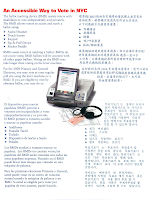I've been meaning to write about this for some time, but got a little side tracked in our
national election-related work. A few weeks ago, a lot of ink was devoted to Governor Paterson's
34 vetoes. Not surprisingly (and quite properly) most of that
attention was focused on the price tag of the various bills he vetoed.
I had a particular interest in one of those 34 bills that didn't have much of a price tag -- Senate Bill 5162. That bill would have required that county boards of election submit ballots to the State Board of Elections for review and approval whenever any state-wide candidate, proposed amendment to the constitution or other question provided by law to be submitted to a statewide vote is printed on a ballot.
Why was I interested in this bill? Because I recently co-authored a
ballot design report that found New York has among the worst ballot design laws in the country -- in particular, the requirements for a full-face paper ballot, the requirement to include a party name and emblem next to every candidate name, requirements to use all capital letters instead of more readable mixed-case letters, and the unusually complicated, jargon-filled instructions provide a text-book example of a state election code that makes designing usable ballots particularly difficult.
New York hasn't had the high-profile ballot design debacles that other states, like California, Florida, Wisconsin and Ohio, have recently had (see the
report if you want to look at how dramatically these debacles have affected high profile elections -- there are an astounding number of examples from just the past decade). But if things don't change, New York will eventually have the bad luck of so many other states. All it takes is a close race. And, as we noted in the report, "as New York makes its transition from lever machines to optical scan systems [next year], the problems caused by [these bad laws] are likely to become more apparent."
The reason I was so interested in Senate Bill 5162 was that it seemed to institute one of our recommendations: namely that State Boards review county-designed ballots (imagine how different history might have been if someone in the Florida Secretary of State's office had reviewed the Palm Beach butterfly ballot and told them that confusing design was unacceptable). Unfortunately, the bill seemed to have some major flaws: it didn't impose a deadline on the State Board for approving or rejecting ballots, and it didn't say what would happen if the bipartisan board became deadlocked and failed to act on a particular ballot.
We were encouraged by the Governor's veto message. He recognized the problems with the bill and made this point:
Poor ballot design remains an issue that often leads to disenfranchisement of voters. The inconsistent placement of candidate names on the ballot face may cause voter confusion and increased error rates. According to a July 2008 report entitled "Better Ballots," by the Brennan Center for Justice, poor ballot design frustrates voters, undermines confidence in the electoral process, and contributes to related Election Day problems. In fact, one state-level recommendation in the report is to have a state election official review local county ballot designs... I encourage the sponsors to work with my office to craft legislation that will help prevent voter confusion in a manner that considers the practical effects on election administration. We hope the legislature will take him up on this offer. New York's election code makes designing a usable ballot far too difficult. That will have major consequences on our elections as we move from lever machines to paper ballots.
 A mailing (to the left) from the New York City Board of Elections earlier this week notified voters that ballot marking devices (BMDs) will be available to voters who need assistance in every precinct. This long overdue development was mandated by the Help America Vote Act (HAVA) of 2002.
A mailing (to the left) from the New York City Board of Elections earlier this week notified voters that ballot marking devices (BMDs) will be available to voters who need assistance in every precinct. This long overdue development was mandated by the Help America Vote Act (HAVA) of 2002.




